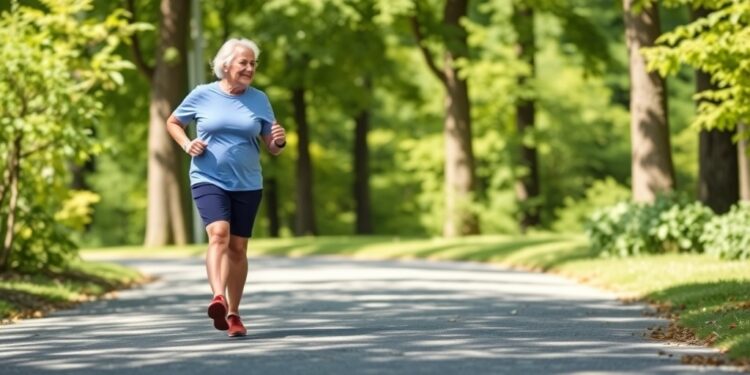A new study unveiled at the American Stroke Association’s International Stroke Conference 2025 proposes a promising avenue for enhancing recovery in stroke survivors. The research indicates that incorporating a structured, progressively intense walking exercise regimen alongside standard rehabilitation protocols can significantly augment both the quality of life and mobility outcomes for patients who have endured strokes. This finding arises from a robust analysis involving 306 participants across 12 different stroke rehabilitation units in Canada, providing vital insights into the effectiveness of exercise during the critical early stage following a stroke.
Stroke, which affects millions globally, poses challenges not just in immediate survival but also in long-term recovery. Rehabilitation protocols often focus on routine physical therapy sessions, but the evidence gathered from this study highlights the critical importance of continuous and challenging physical activity as an integral component of recovery. Participants in the new exercise protocol were instructed to engage in a minimum of 30 minutes of daily weight-bearing and walking exercises, designed to escalate in intensity as their abilities improved. This approach aimed to stimulate neuroplasticity, which refers to the brain’s ability to reorganize itself and create new neural pathways, a critical factor for recovery.
The weighted exercises were closely monitored through wearable technology, which tracked the heart rates and step counts of the participants. This technological intervention not only provided real-time feedback to ensure participants remained within their safe exercising limits but also encouraged motivation through tangible progress assessment. Results demonstrated a notable increase in the average distances walked during the six-minute walking test, confirming that higher-intensity walking activities lead to greater improvements in physical capacity compared to standard care.
Exploring the intricacies of post-stroke rehabilitation presents a pressing need for healthcare professionals to adopt practices that foster engagement and progression. The study’s co-author, Dr. Janice Eng, emphasized the significant gap between existing rehabilitation guidelines and their practical application in clinical settings. The American Stroke Association has advocated for rigorous exercise regimens, yet many rehabilitation programs have yet to be sufficiently intensified to meet these recommendations. This trial not only bridges that gap but sets a precedent for integrating progressive exercise into everyday protocols.
Clinical data collected throughout the trial indicate that the participants who engaged in the higher-intensity protocol exhibited improvements across various metrics of health, including quality of life assessments, balance, mobility, and gait speed. Such enhancements are crucial for stroke survivors aiming to regain independence and functionality. Additionally, the noted increase in endurance levels translated into reduced disability, which is especially pertinent in the early recovery stages when rehabilitation motivations and outcomes are directly correlated.
Therapist training was another pivotal aspect of this research. All therapists involved in the trial received comprehensive training to implement the new protocols effectively within their units. This model demonstrated a successful implementation of clinical practice changes, resulting in positive outcomes from a real-world perspective. This highlights an encouraging trend that enables other healthcare facilities to adopt similar methodologies, ultimately benefiting a larger patient population.
However, it is essential to approach these findings cautiously. The study’s limitations include a precondition that participants needed to take at least five steps independently, potentially excluding more severely impacted individuals. Future research may address these gaps by exploring adaptations of the program for a broader range of mobility capabilities.
The study calls for renewed efforts to incorporate more dynamic and intensive therapies into rehabilitation units actively. As post-stroke recovery remains a multifaceted challenge, the evidence gathered supports a shift toward robust physical engagement rather than relying solely on passive rehabilitation techniques. Thus, the findings present a clarion call to healthcare providers to rethink traditional therapy strategies in favor of approaches that emphasize active participation.
The implications of such research extend beyond individual facilities; they may reshape policy recommendations regarding stroke rehabilitation practices across health systems worldwide. Such transformation requires collaboration among researchers, clinicians, and public health officials to validate and standardize enhanced rehabilitation protocols that prioritize patients’ physical activity levels. Stakeholders must recognize the evolving landscape of stroke recovery and the evidence supporting rigorous exercise frameworks.
With the acknowledgment of these advancements in stroke rehabilitation, the hope is for a paradigm shift in how care is delivered post-stroke. The progress noted among early intervention practices signals a brighter future for stroke survivors, underlining the urgency for enhanced clinical training and program development. By harnessing data-driven approaches and adhering to best practices in physical therapy, the broader healthcare community can collectively elevate standards of care that cater to the nuances of stroke recovery.
Concluding, the findings presented at the International Stroke Conference invite renewed dialogue on the role of exercise in rehabilitation programs. They expand upon existing frameworks and inspire innovative thinking about patient care. By committing to the integration of structured and progressive exercise into rehabilitation routines, healthcare professionals can potentially alter the course of recovery for stroke patients, fostering not only physical improvements but also holistic well-being in this vulnerable population.
Subject of Research: The impact of progressive walking exercise on recovery in stroke patients.
Article Title: Progressive Exercises Improve Life Quality for Stroke Survivors.
News Publication Date: Jan. 30, 2025.
Web References: American Stroke Association
References: To be published as a full manuscript in a peer-reviewed scientific journal.
Image Credits: Not specified.
Keywords
Stroke rehabilitation, physical therapy, exercise, neuroplasticity, quality of life, mobility improvements, clinical practice, rehabilitation protocols, health outcomes.
Tags: American Stroke Association researchbenefits of physical activity post-strokeCanadian stroke rehabilitation studycritical recovery stages for stroke patientsearly recovery outcomes for stroke survivorsenhancing mobility after strokehigh-intensity walking exercisesneuroplasticity and stroke recoveryprogressive walking exercise protocolsquality of life improvement in stroke rehabilitationstroke rehabilitation strategiesstructured exercise regimen for stroke patients





